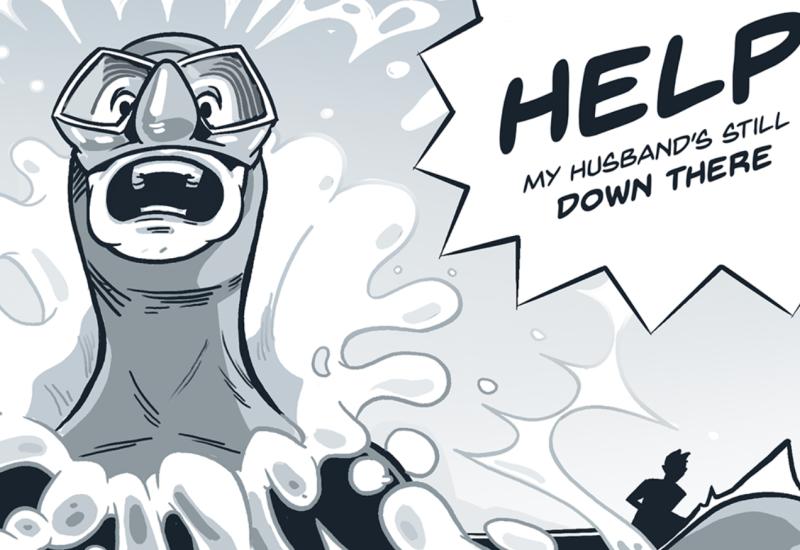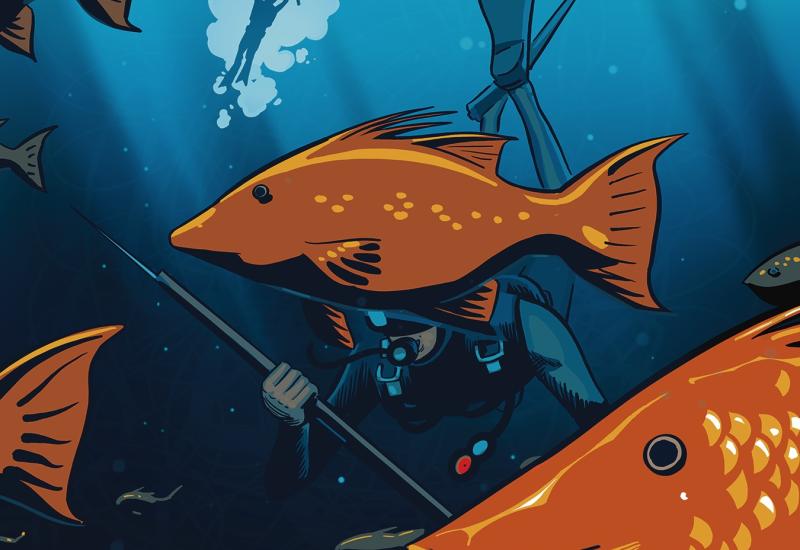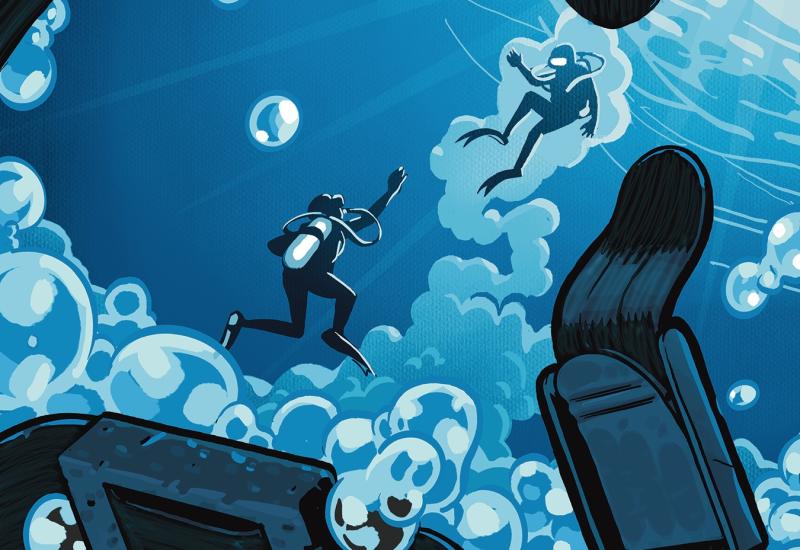Swimming Upstream
August 2003
It must have seemed like a cruel joke. Rene struggled forward, kicking as hard as she could, but the anchor line never seemed to get any closer. Just minutes into the dive, she was already exhausted, her heart was pounding, and every panting breath did little to satisfy her constant craving for more air.
Still kicking to reach the line, she crashed onto the wreck at 90 feet. Allen was nowhere in sight. She glanced at her gauge and discovered that she had already used two-thirds of her air. Anxiety immediately turned to panic, and Rene grabbed her power inflator and began clawing her way up into the water column. She had to get to the surface. She had to get air.
The Divers
Rene was a certified open-water diver in her late twenties. She had logged a number of dives, most of them in quarries and lakes. Although she considered herself in good health, Rene was a classic couch potato with poor cardiovascular conditioning. Her dive buddy, Allen, was a few years older with slightly more dive experience, but he also had made only a few ocean dives.
The Dive
The Pacific Ocean was cool, but visibility was good in spite of choppy surface conditions and a brisk wind out of the west. The dive boat anchored over a current-swept wreck lying at a maximum depth of 95 feet. The dive briefing provided the divers with the depth, gave the orientation of the wreck, and noted a quarter-knot surface current. The captain directed the divers to use the surface line to pull themselves from the stern to the anchor line before descending.
Feeling seasick from the moderate chop, Rene and Allen were the first divers to enter the water, but instead of pulling themselves along the current line, the pair began swimming forward. The surface chop and the physical exertion aggravated Allen's queasiness, and he threw up on the surface. Regaining his composure, Allen signaled to Rene that they should descend immediately to avoid the chop, then swim for the descent line. Rene flashed an OK sign and both divers lifted their BC inflator hoses to dump air and begin the descent.
The Accident
As they turned into the current and began kicking, Allen was glad to be out of the chop, but suddenly anxious about making his first free descent in the open ocean. The line was in sight about 15 yards ahead, but the deeper he sank, the more the line angled away from him. Finning against the current, Allen kicked harder and harder, but never seemed to get closer to the line.
He looked up and ahead to see Rene also struggling. A constant stream of bubbles swirled out of her regulator, trailing off in the current behind her. As she descended, Rene also kicked toward the anchor line with increasing intensity. Unaccustomed to such physical exertion, she was experiencing high levels of carbon dioxide in her bloodstream. This, along with the anxiety created by her lack of progress toward the line, caused her breathing rate to accelerate.
Making matters worse, the constant descent meant each breath of air was more dense than the last, decreasing the efficiency of gas exchange in her lungs. She was caught in a classic panic cycle: The faster she breathed, the higher her carbon dioxide level. The higher her carbon dioxide level, the faster she tried to breathe. As her anxiety grew, it's likely that Rene also experienced a fixation on reaching the descent line, which always seemed to elude her grasp.
Allen was also finding it difficult to breathe. The wreck was in view now, and Allen slowed his pace, content just to reach the bottom and duck into the lee behind the vessel. Rene continued swimming forward, still trying to reach the descent line.
When Rene crashed onto the deck, Allen noticed her movements were erratic. When she turned to look at her pressure gauge, Allen saw the panic on her face. Before he could reach her, Rene grabbed her power inflator and bolted toward the surface. Her rapid ascent was soon out of control and she popped to the surface, well down current from the boat. She spit out her regulator and ripped off her mask to scream for help, but choked on seawater. By the time the crew arrived to help, Rene was unconscious and no longer breathing. Attempts to revive her were unsuccessful.
Analysis
Rene's poor physical conditioning would not have been fatal had she and Allen followed the captain's instructions.
Seasickness further weakened their physical condition and probably added significant psychological stress.
Lessons for Life
-
Listen to dive briefings. Failure to follow the advice of the captain and crew is a common cause of diving accidents.
-
Get fit. Diving in currents can require short bursts of physical exertion equivalent to running a sprint.
-
Duck currents. The drag caused by gear makes swimming against moderate currents very difficult.
-
Know when to quit. If you begin to hyperventilate or become anxious, stop all physical activity and get your breathing under control before making a slow ascent. Remain calm: It's better to surface down current from the boat than to panic.
-
Keep your gear. Always keep your mask and regulator in place at the surface, especially in an emergency.
August 2003
It must have seemed like a cruel joke. Rene struggled forward, kicking as hard as she could, but the anchor line never seemed to get any closer. Just minutes into the dive, she was already exhausted, her heart was pounding, and every panting breath did little to satisfy her constant craving for more air.
Still kicking to reach the line, she crashed onto the wreck at 90 feet. Allen was nowhere in sight. She glanced at her gauge and discovered that she had already used two-thirds of her air. Anxiety immediately turned to panic, and Rene grabbed her power inflator and began clawing her way up into the water column. She had to get to the surface. She had to get air.
The Divers
Rene was a certified open-water diver in her late twenties. She had logged a number of dives, most of them in quarries and lakes. Although she considered herself in good health, Rene was a classic couch potato with poor cardiovascular conditioning. Her dive buddy, Allen, was a few years older with slightly more dive experience, but he also had made only a few ocean dives.
The Dive
The Pacific Ocean was cool, but visibility was good in spite of choppy surface conditions and a brisk wind out of the west. The dive boat anchored over a current-swept wreck lying at a maximum depth of 95 feet. The dive briefing provided the divers with the depth, gave the orientation of the wreck, and noted a quarter-knot surface current. The captain directed the divers to use the surface line to pull themselves from the stern to the anchor line before descending.
Feeling seasick from the moderate chop, Rene and Allen were the first divers to enter the water, but instead of pulling themselves along the current line, the pair began swimming forward. The surface chop and the physical exertion aggravated Allen's queasiness, and he threw up on the surface. Regaining his composure, Allen signaled to Rene that they should descend immediately to avoid the chop, then swim for the descent line. Rene flashed an OK sign and both divers lifted their BC inflator hoses to dump air and begin the descent.
The Accident
As they turned into the current and began kicking, Allen was glad to be out of the chop, but suddenly anxious about making his first free descent in the open ocean. The line was in sight about 15 yards ahead, but the deeper he sank, the more the line angled away from him. Finning against the current, Allen kicked harder and harder, but never seemed to get closer to the line.
He looked up and ahead to see Rene also struggling. A constant stream of bubbles swirled out of her regulator, trailing off in the current behind her. As she descended, Rene also kicked toward the anchor line with increasing intensity. Unaccustomed to such physical exertion, she was experiencing high levels of carbon dioxide in her bloodstream. This, along with the anxiety created by her lack of progress toward the line, caused her breathing rate to accelerate.
Making matters worse, the constant descent meant each breath of air was more dense than the last, decreasing the efficiency of gas exchange in her lungs. She was caught in a classic panic cycle: The faster she breathed, the higher her carbon dioxide level. The higher her carbon dioxide level, the faster she tried to breathe. As her anxiety grew, it's likely that Rene also experienced a fixation on reaching the descent line, which always seemed to elude her grasp.
Allen was also finding it difficult to breathe. The wreck was in view now, and Allen slowed his pace, content just to reach the bottom and duck into the lee behind the vessel. Rene continued swimming forward, still trying to reach the descent line.
When Rene crashed onto the deck, Allen noticed her movements were erratic. When she turned to look at her pressure gauge, Allen saw the panic on her face. Before he could reach her, Rene grabbed her power inflator and bolted toward the surface. Her rapid ascent was soon out of control and she popped to the surface, well down current from the boat. She spit out her regulator and ripped off her mask to scream for help, but choked on seawater. By the time the crew arrived to help, Rene was unconscious and no longer breathing. Attempts to revive her were unsuccessful.
Analysis
Rene's poor physical conditioning would not have been fatal had she and Allen followed the captain's instructions.
Seasickness further weakened their physical condition and probably added significant psychological stress.
Lessons for Life
Listen to dive briefings. Failure to follow the advice of the captain and crew is a common cause of diving accidents.
Get fit. Diving in currents can require short bursts of physical exertion equivalent to running a sprint.
Duck currents. The drag caused by gear makes swimming against moderate currents very difficult.
Know when to quit. If you begin to hyperventilate or become anxious, stop all physical activity and get your breathing under control before making a slow ascent. Remain calm: It's better to surface down current from the boat than to panic.
Keep your gear. Always keep your mask and regulator in place at the surface, especially in an emergency.










